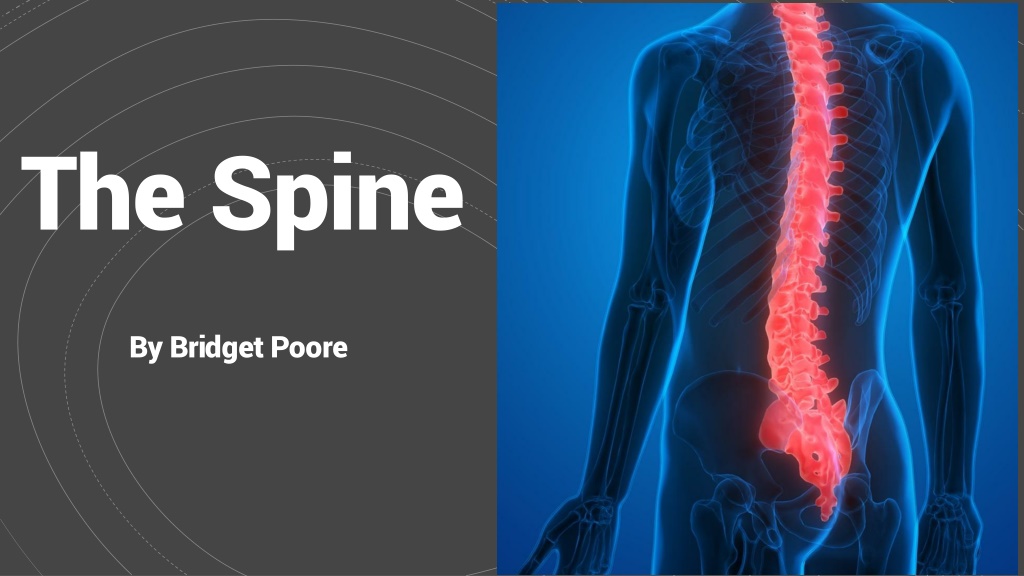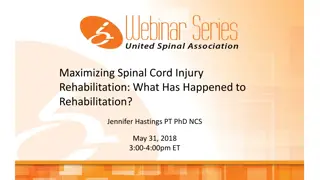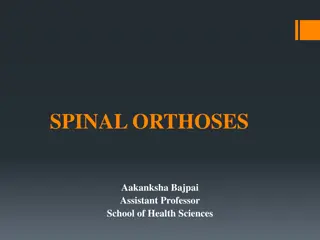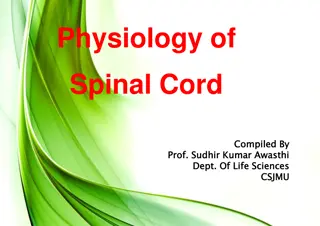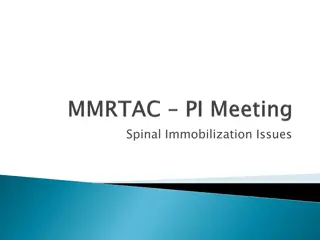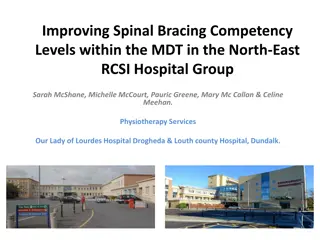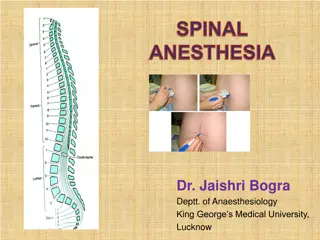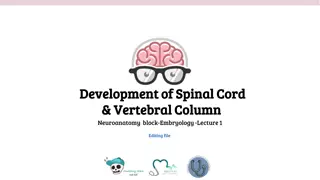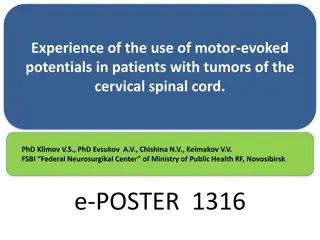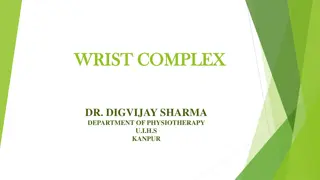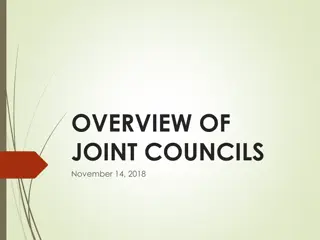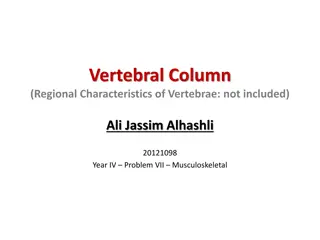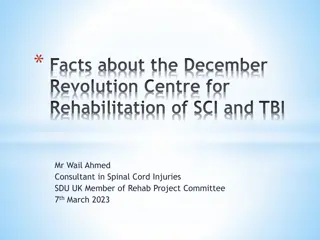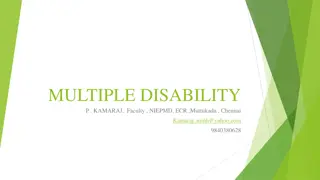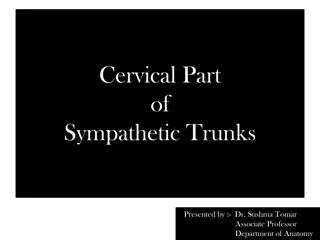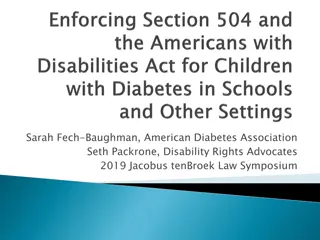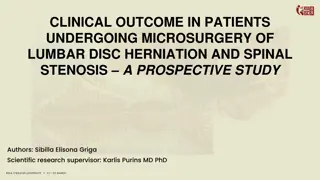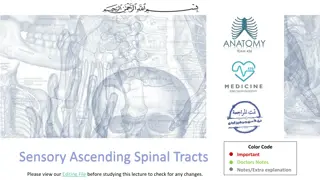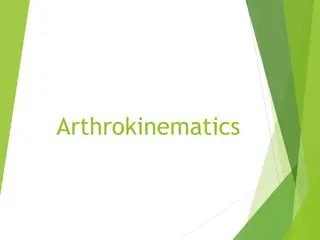Understanding Joint Disabilities and Ankylosis in Spinal Health
Factors contributing to joint disabilities in spinal health include limited or excessive movement, muscle weakness, and fatigue. Painful motion, muscle spasm, and joint alignment issues can indicate disability. Ankylosis, seen in conditions like ankylosing spondylitis, results in joint fusion and immobility. Diagnostic codes help evaluate conditions like intervertebral disc syndrome. Genetic factors play a role in ankylosing spondylitis, causing abnormal stiffening of joints. Assessment criteria for spinal range of motion abnormalities are also outlined.
Uploaded on Sep 29, 2024 | 0 Views
Download Presentation

Please find below an Image/Link to download the presentation.
The content on the website is provided AS IS for your information and personal use only. It may not be sold, licensed, or shared on other websites without obtaining consent from the author. Download presentation by click this link. If you encounter any issues during the download, it is possible that the publisher has removed the file from their server.
E N D
Presentation Transcript
The Spine By Bridget Poore
As regards the joints the factors of disability reside in reductions of their normal excursion of movements in different plane Inquiry will be directed to these considerations: 4.45 The joints. (a) Less movement than normal (due to ankylosis, limitation or blocking, adhesions, tendon- tie- up, contracted scars, etc.). (b) More movement than normal (from flail joint, resections, nonunion of fracture, relaxation of ligaments, etc.). (c) Weakened movement (due to muscle injury, disease or injury of peripheral nerves, divided or lengthened tendons, etc.). (d) Excess fatigability.
With any form of arthritis, painful motion is an important factor of disability, carefully note facial expression, wincing, etc., with pressure or manipulation, should be carefully noted and related to affected joints Muscle spasm will greatly assist the identification. Sciatic neuritis is not uncommonly caused by arthritis of the spine. The intent of the schedule is to recognize painful motion with joint or periarticular pathology as productive of disability. It is the intention to recognize painful, unstable, or misaligned joints, due to healed injury, as entitled to at least the minimum compensable rating for the joint. Crepitation either in the soft tissues such as the tendons or ligaments, or crepitation within the joint structures should be noted carefully as points of contact which are diseased. Flexion elicits such manifestations. The joints involved should be tested for pain on both active and passive motion, in weight- bearing and no weight- bearing and, if possible, with the range of the opposite undamaged joint. 4.59 Painful motion.
Diagnostic Codes 5235-5243 4.71 Use General Rating for diagnostic codes 5235 to 5243 unless 5243 is evaluated under the Formula for Rating Intervertebral Disc Syndrome Based on Incapacitating Episodes General Rating Formula With or without symptoms such as pain Radiating or non-radiating pain Stiffness or aching in the area of the spine affected by residuals of injury or disease
What causes ankylosis? Ankylosing spondylitis has no known specific cause, though genetic factors seem to be involved. People who have a gene called HLA- B27 are at a greatly increased risk of developing ankylosing spondylitis. However, only some people with the gene develop the condition. Ankylosis abnormal stiffening immobility of a joint due to the fusion of the bones
10% Forward flexion of the thoracolumbar spine greater than 60 degrees but not greater than 85 degrees or forward flexion of the cervical spine greater than 30 degrees but not greater than 40 degrees or combined range of motion of the thoracolumbar spine greater than 120 degrees but not greater than 235 degrees; or combined range of motion of the cervical spine greater than 170 degrees but not greater than 335 degrees or muscle spasm, guarding, or localized tenderness not resulting in abnormal gait or abnormal spinal contour or vertebral body fracture with loss of 50 percent or more of the height
20% Forward flexion thoracolumbar spine greater than 30 degrees but not greater than 60 degrees or forward flexion cervical spine greater than 15 degrees but not greater than 30 degrees or the combined range of motion of the thoracolumbar spine not greater than 120 degrees or the combined range of motion of the cervical spine not greater than 170 degrees or muscle spasm or guarding severe enough to result in an abnormal gait or abnormal spinal contour such as scoliosis, reversed lordosis, or abnormal kyphosis
30% Forward flexion cervical spine 15 degrees or less; or, favorable ankylosis entire cervical spine 40% Unfavorable ankylosis of the entire cervical spine; or, forward flexion of the thoracolumbar spine 30 degrees or less; or, favorable ankylosis of the entire thoracolumbar spine 50% Unfavorable ankylosis entire thoracolumbar spine 100% Unfavorable ankylosis entire spine
Note: (1) Evaluate any associated objective neurological abnormalities, including, but not limited to, bowel or bladder impairment, separately
Normal forward flexion cervical spine is 0 to 45 degrees left and right lateral flexion are 0 to 45 degrees Normal forward flexion thoracolumbar spine is zero to 90 degrees, left and right lateral flexion are zero to 30 degrees *Combined range of motion refers to the sum of the range of forward flexion extension, left and right lateral flexion, and left and right rotation extension, left and right lateral flexion, and left and right rotation Extension is 0 to 45 degrees Note: (2) left and right lateral rotation are 0 to 80 degrees extension is zero to 30 degrees left and right lateral rotation are zero to 30 degrees *normal combined range of motion of the cervical spine is 340 degrees and of the thoracolumbar spine is 240 degrees. The normal ranges of motion for each component of spinal motion provided in this note are the maximum that can be used for calculation of the combined range of motion.
Note: (3) Note: (3) In exceptional cases, an examiner may state that because of age body habitus neurologic disease, other factors not the result of disease or injury of the spine *range of motion of the spine in those individuals should be considered normal even though it does not conform to the normal range of motion *examiner s assessment that the range of motion is normal for that individual will be accepted with an explanation of the circumstance Note: (4) Round each range of motion measurement to the nearest five degrees
Note: (5) Note: (5) Unfavorable ankylosis is a condition in which the entire cervical spine, the entire thoracolumbar spine, or the entire spine is fixed in flexion or extension, and the ankylosis results in one or more of the following: difficulty walking because of a limited line of vision restricted opening of the mouth and chewing breathing limited to diaphragmatic respiration gastrointestinal symptoms due to pressure of the costal margin on the abdomen dyspnea or dysphagia atlantoaxial or cervical subluxation or dislocation neurologic symptoms due to nerve root stretching. Fixation of a spinal segment in neutral position (zero degrees) always represents favorable ankylosis.
Note: (6) Note: (6) Thoracolumbar and cervical spine segments are evaluated separately except when there is unfavorable ankylosis of both segments, which will be rated as a single disability. Other Related Diagnostic Codes 5235 Vertebral fracture or dislocation 5236 Sacroiliac injury and weakness 5237 Lumbosacral or cervical strain 5238 Spinal stenosis 5239 Spondylolisthesis or segmental instability 5240 Ankylosing spondylitis 5241 Spinal fusion 5242 Degenerative arthritis of the spine (see also diagnostic code 5003) 5243 Intervertebral disc syndrome
Rating Formula Rating for Intervertebral Disc Syndrome Based on Incapacitating Episodes (5243)
Evaluate intervertebral disc syndrome (preoperatively or postoperatively) either under the General Rating Formula for Diseases and Injuries of the Spine or under the Formula for Rating Intervertebral Disc Syndrome Based on Incapacitating Episodes, whichever method results in the higher evaluation when all disabilities are combined under 4.25. DC5242- Degenerative Arthritis either 5003 or 5010) Clarification added Degenerative Disc Disease other than intervertebral disc syndrome (see DC 5243 Intervertebral Disc Syndrome Clarification Added Assign this diagnostic code only when there is a disc herniation with compression and/or irritation of the adjacent nerve root; assign diagnostic code 5242 for all other disc diagnosis
60% With incapacitating episodes having a total duration of at least 6 weeks during the past 12 months 40% With incapacitating episodes having a total duration of at least 4 weeks but less than 6 weeks during the past 12 months 20% With incapacitating episodes having a total duration of at least 2 weeks but less than 4 weeks during the past 12 months 10% With incapacitating episodes having a total duration of at least one week but less than 2 weeks during the past 12 months
Note: (1) Evaluations under diagnostic code 5243, an incapacitating episode is a period of acute signs and symptoms due to intervertebral disc syndrome that requires bed rest prescribed by a physician and treatment by a physician. Note: (2) If intervertebral disc syndrome is present in multiple spinal segment, with clearly distinct effects in each spinal segment, evaluate individual segments based on Incapacitating Episodes or under the General Rating Formula for Diseases and Injuries of the Spine, use method that results in a higher evaluation for the segment.
Example 5243 LUMBOSACRAL STRAIN WITH INTERVERTEBRAL DISC SYNDROME 1. Evaluation of lumbosacral strain with intervertebral disc syndrome (previously rated as lumbago) currently evaluated as 10 percent disabling. The evaluation of lumbosacral strain with intervertebral disc syndrome (previously rated as lumbago) is increased to 40 percent disabling effective October 29, 2021. (38 CFR 4.1, 38 CFR 3.400) The effective date of this grant is October 29, 2021. The increased evaluation has been established from the day VA received your intent to file (ITF) a claim for compensation. (38 CFR 3.155, 38 CFR 3.400) We have assigned a 40 percent evaluation for your lumbosacral strain with intervertebral discsyndrome based on: Forward flexion of the thoracolumbar spine 30 degrees or less Additional symptom(s) include: Combined range of motion of the thoracolumbar spine not greater than 120 degrees Localized tenderness not resulting in abnormal gait or abnormal spinal contour Painful motion The provisions of 38 CFR 4.40 and 4.45 concerning functional loss due to pain, fatigue, weakness, or lack of endurance, incoordination, and flare- ups, as cited in DeLuca v. Brown and Mitchell v. Shinseki, have been considered and were applied based on additional joint limitation.
Example 5243 LUMBOSACRAL STRAIN 1. Evaluation of lumbosacral strain currently evaluated as 10 percent disabling. The evaluation of lumbosacral strain is increased to 20 percent disabling effective August 27, 2019. (38 CFR 4.1, 38 CFR 3.400) The effective date of this grant is August 27, 2019, the date the VA received your claim for increase as you have continuously pursued your claim within a year following a decision based on failure to show for the prior examination. (38 CFR 3.2500, 38 CFR 3.400) During the examination conducted on February 20, 2020, the examiner reported abnormal range of motions with pain. There was a slight decrease in muscle strength testing during knee extension, ankle plantar flexion, and ankle dorsiflexion on both lower extremities. There were no muscular atrophy or ankylosis noted. Deep tendon reflexes and sensory exams were normal. We have assigned a 20 percent evaluation for your lumbosacral strain based on: Forward flexion of the thoracolumbar spine greater than 30 degrees but not greater than 60 degrees Guarding severe enough to result in an abnormal gait or abnormal spinal contour such as scoliosis, reversed lordosis, or abnormal kyphosis Muscle spasm severe enough to result in an abnormal gait or abnormal spinal contour such as scoliosis, reversed lordosis, or abnormal kyphosis
